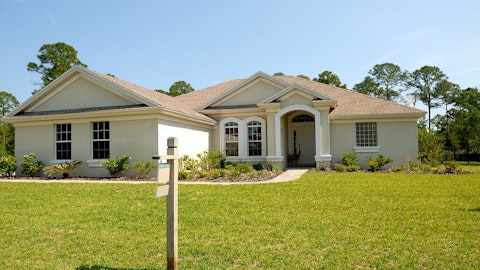Ensemble Capital Management, an investment management firm, published its fourth-quarter 2020 Investor Letter – a copy of which can be downloaded here. In the letter, they discussed the whole year performance of the fund in 2020 and also gave insights on the investment decisions they’ve made last year. You can view the fund’s top 10 holdings to have a peek at their top bets for 2021.
Ensemble Capital Management, in their Q4 2020 Investor Letter said that they consider NVR, Inc. (NYSE: NVR) as one of the detractors from their performance. NVR, Inc. is a homebuilding and mortgage banking company that currently has a $16.5 billion market cap. For the past 3 months, NVR delivered a 12.48% return and settled at $4,446.48 per share at the closing of January 29th.
Here is what Ensemble Capital Management has to say about NVR, Inc. in their investor letter:
“A notable detractor from our performance came from our investment in NVR, Incorporated. NVR is unique home builder and is one of our featured companies which we discuss later in this letter. Similar to Home Depot, the stock exhibited strong performance during the second and third quarter, but the share price was almost exactly unchanged during the fourth quarter. We believe that US home builders as a group have underbuilt vs the level of demand over the last decade, after the group overbuilt on their way into the Financial Crisis. With a large opportunity ahead of it to meet high levels of home demand, we are enthusiastic about NVR’s potential.
In late 2019, we started a position in homebuilder NVR. You may know them better by their consumer-facing subsidiary brands, especially Ryan Homes.
At Ensemble, we would not be interested in investing in most homebuilders. The three key attributes that we insist upon for any holding are a competitive moat, strong management, and business forecastability. At first glance, homebuilders don’t check off any of these boxes. There’s little differentiation between most home builders, their management teams tend to be pro-cyclical, and housing demand is a cocktail of hard-to-predict factors. Nevertheless, we think NVR is an exceptionally well run business, with strong competitive advantages, and a business model that is far more forecastable than its peers.
NVR doesn’t have a traditional moat. Its unique business model is theoretically replicable, but despite NVR’s long track record of superior results, its competitors are either unwilling or unable to adjust their operations.
Like another one of our holdings, First Republic Bank, there’s a cultural reason why competitors can’t fully replicate NVR’s strategy. Homebuilders typically start out as land developers and are therefore used to and drawn to the short-term, leveraged returns that the land speculation business can bring. In contrast, NVR plays a slow-and-steady long game.
To play such a game in the homebuilding industry, NVR uses a differentiated business model. Rather than do homebuilding and land development like the rest of the industry, NVR only focuses on homebuilding. NVR uses options to control land, which gives them the right but not the obligation to buy a parcel.
Compared to developers who may end up with land no one wants, NVR only exercises the option when there’s clear demand to build on the land.
Despite NVR’s land-light strategy’s success, the industry’s use of land options remains lower than it was during the housing boom in 2004-2006. It is really hard for traditional homebuilders resist the land development game.
National homebuilders also enjoy the prestige of having the largest national market share. While there are perks to this strategy, it is inefficient from an operational standpoint. Put simply, they are too spread out. In contrast, NVR focuses just on land east of the Mississippi River and aims to maximize regional market share.
NVR may not have the highest profit margins in a strong housing market, but it also does not see profits crash in a housing downturn. During the housing crisis a decade ago, NVR was the only major homebuilder to make a profit every year.
Breaking apart NVR’s return on equity into its three components, we can understand why its strategy is so successful. Most homebuilders report similar profit margins and asset turnover ratios. They then use large amounts of debt to augment their returns on equity.
NVR’s operations report higher profit margins and most importantly, they turn their inventory faster than their peers. This allows them to use less leverage to achieve strong returns on equity. By having a healthier balance sheet than its peer group, NVR is better positioned to survive and capitalize on opportunities in a downswing.
An underappreciated part of NVR’s business model is its pre-fabrication factory network. NVR has seven factories scattered across its territory, from which it pre-fabricates building materials like framing, panels, doors, and other components for its communities. Roughly 90% of NVR’s communities are serviced by its factory network and most of NVR’s communities are within 100 miles of its factories.
The pre-fab factories do a few things for NVR. They allow NVR to build off-site in all types of weather, the factories are shipping destinations for suppliers, and rather than have suppliers deliver to hundreds of sites in an area, NVR has them deliver directly to the factories, which increases supply chain and manufacturing efficiency.
We’re only just now seeing homebuilders come around to the benefits of pre-fab factories, but NVR has been using them since the 1990s. In addition, NVR has density advantages stemming from its market share strategy that will be hard to match for both upstarts and incumbents looking to make pre-fab factories work for them.
Unlike most homebuilders, NVR broadly avoids competing in top metro areas, instead opting for promising secondary and tertiary metro areas like Richmond, Virginia and Greenville, South Carolina. A key factor in homebuilder profitability is finding cheap but still desirable land. That generally means exurban locations, 25 miles or more away from the metro area, and NVR has shown a knack for identifying cheap but promising land.
Fortunately for NVR, its geographic niche is in high demand right now. COVID related quarantines and the rise of remote work opportunities has made secondary and tertiary cities as well as exurban locations more attractive than they were previously.
NVR has other tailwinds at its back, including the peak millennial cohort entering household formation years, a shortage of existing homes for sale, and low mortgage rates. Single family home starts have yet to recover from the housing crisis after a decade of underdevelopment. As you might expect, homebuilder sentiment is at all-time highs.
We think the current housing cycle has years of expansionary activity ahead, but we take additional confidence in knowing that NVR outperforms its peers in down cycles and indeed gets stronger in them. That’s why we increased our holding in March and April. The market sold off all the homebuilders, but we were confident that NVR would capitalize on any industry weakness.
Finally, another important component of our NVR thesis is our confidence in its management team who are proven top notch capital allocators. For example, they do not pay dividends because they believe them to be tax inefficient and return all free cash flow through buybacks. Buybacks also afford them flexibility during market uncertainty while dividends are considered commitments by investors. As mentioned earlier, NVR keeps a conservative balance sheet for the same reason.
We think the homebuilding industry has a number of multiyear tailwinds at its back and that NVR is uniquely positioned to capitalize across the cycle.”

Last December 2020, we published an article telling that NVR, Inc. (NYSE: NVR) was in 42 hedge fund portfolios, its all time high statistics. NVR delivered a decent 16.49% return in the past 12 months.
Our calculations show that NVR, Inc. (NYSE: NVR) does not belong in our list of the 30 most popular stocks among hedge funds.
The top 10 stocks among hedge funds returned 216% since the end of 2014 and outperformed the S&P 500 Index ETFs by more than 121 percentage points. We know it sounds unbelievable. You have been dismissing our articles about top hedge fund stocks mostly because you were fed biased information by other media outlets about hedge funds’ poor performance. You could have doubled the size of your nest egg by investing in the top hedge fund stocks instead of dumb S&P 500 ETFs. Below you can watch our video about the top 5 hedge fund stocks right now. All of these stocks had positive returns in 2020.
Video: Top 5 Stocks Among Hedge Funds
At Insider Monkey we scour multiple sources to uncover the next great investment idea. For example, Federal Reserve has been creating trillions of dollars electronically to keep the interest rates near zero. We believe this will lead to inflation and boost real estate prices. So, we recommended this real estate stock to our monthly premium newsletter subscribers. We go through lists like the 10 most profitable companies in the world to pick the best large-cap stocks to buy. Even though we recommend positions in only a tiny fraction of the companies we analyze, we check out as many stocks as we can. We read hedge fund investor letters and listen to stock pitches at hedge fund conferences. You can subscribe to our free daily newsletter on our website.
Disclosure: None. This article is originally published at Insider Monkey.





